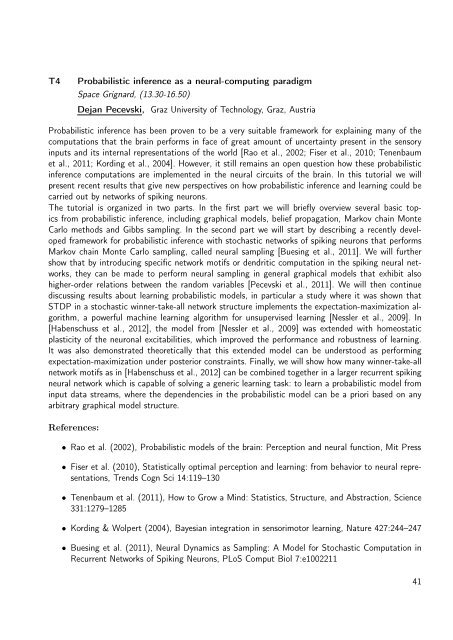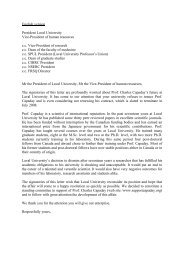Untitled - Laboratory of Neurophysics and Physiology
Untitled - Laboratory of Neurophysics and Physiology
Untitled - Laboratory of Neurophysics and Physiology
Create successful ePaper yourself
Turn your PDF publications into a flip-book with our unique Google optimized e-Paper software.
T4<br />
Probabilistic inference as a neural-computing paradigm<br />
Space Grignard, (13.30-16.50)<br />
Dejan Pecevski, Graz University <strong>of</strong> Technology, Graz, Austria<br />
Probabilistic inference has been proven to be a very suitable framework for explaining many <strong>of</strong> the<br />
computations that the brain performs in face <strong>of</strong> great amount <strong>of</strong> uncertainty present in the sensory<br />
inputs <strong>and</strong> its internal representations <strong>of</strong> the world [Rao et al., 2002; Fiser et al., 2010; Tenenbaum<br />
et al., 2011; Kording et al., 2004]. However, it still remains an open question how these probabilistic<br />
inference computations are implemented in the neural circuits <strong>of</strong> the brain. In this tutorial we will<br />
present recent results that give new perspectives on how probabilistic inference <strong>and</strong> learning could be<br />
carried out by networks <strong>of</strong> spiking neurons.<br />
The tutorial is organized in two parts. In the first part we will briefly overview several basic topics<br />
from probabilistic inference, including graphical models, belief propagation, Markov chain Monte<br />
Carlo methods <strong>and</strong> Gibbs sampling. In the second part we will start by describing a recently developed<br />
framework for probabilistic inference with stochastic networks <strong>of</strong> spiking neurons that performs<br />
Markov chain Monte Carlo sampling, called neural sampling [Buesing et al., 2011]. We will further<br />
show that by introducing specific network motifs or dendritic computation in the spiking neural networks,<br />
they can be made to perform neural sampling in general graphical models that exhibit also<br />
higher-order relations between the r<strong>and</strong>om variables [Pecevski et al., 2011]. We will then continue<br />
discussing results about learning probabilistic models, in particular a study where it was shown that<br />
STDP in a stochastic winner-take-all network structure implements the expectation-maximization algorithm,<br />
a powerful machine learning algorithm for unsupervised learning [Nessler et al., 2009]. In<br />
[Habenschuss et al., 2012], the model from [Nessler et al., 2009] was extended with homeostatic<br />
plasticity <strong>of</strong> the neuronal excitabilities, which improved the performance <strong>and</strong> robustness <strong>of</strong> learning.<br />
It was also demonstrated theoretically that this extended model can be understood as performing<br />
expectation-maximization under posterior constraints. Finally, we will show how many winner-take-all<br />
network motifs as in [Habenschuss et al., 2012] can be combined together in a larger recurrent spiking<br />
neural network which is capable <strong>of</strong> solving a generic learning task: to learn a probabilistic model from<br />
input data streams, where the dependencies in the probabilistic model can be a priori based on any<br />
arbitrary graphical model structure.<br />
References:<br />
• Rao et al. (2002), Probabilistic models <strong>of</strong> the brain: Perception <strong>and</strong> neural function, Mit Press<br />
• Fiser et al. (2010), Statistically optimal perception <strong>and</strong> learning: from behavior to neural representations,<br />
Trends Cogn Sci 14:119–130<br />
• Tenenbaum et al. (2011), How to Grow a Mind: Statistics, Structure, <strong>and</strong> Abstraction, Science<br />
331:1279–1285<br />
• Kording & Wolpert (2004), Bayesian integration in sensorimotor learning, Nature 427:244–247<br />
• Buesing et al. (2011), Neural Dynamics as Sampling: A Model for Stochastic Computation in<br />
Recurrent Networks <strong>of</strong> Spiking Neurons, PLoS Comput Biol 7:e1002211<br />
41



